
Capacitor bank 1.5 kJ 2004
SCR (silicon controlled rectifier) switching
is used to control peak currents of
thousands of amps mostly to make big bangs but also to drive projectile devices such
as a rail gun and
coil gun. Power is 1500 Joules at 4700 uF 800 V from 4 electrolytic
capacitors rated at 4700uf 400V each.
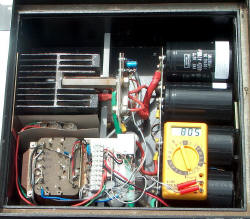 (click to enlarge)
(click to enlarge)
The heavy duty SCR was one of 3 still functioning that I obtained from a 3 phase 400 A controller
I got from a scrap yard for A$50. I have blown one of them into a
very low impedance unloaded coilgun. They come with a solid heat
sink and heavy gauge leads. The heat sink is not needed for this application
since there is little transfer of heat with these single pulses of typically a few
tens of milliseconds, however I don't have the tools to remove them. The 4
capacitors are 4700 uF 400 V. The charging transformer from an ancient TV is bottom left with
voltage doubler and relay. The SCR drive electronics and protection
diodes are upper centre. The drive electronics come from Sam Barros' site
in Links which is an excellent source of HV
information. It all fits with a bit of a squeeze in a lockable glass fronted
aluminium case.
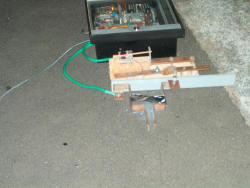
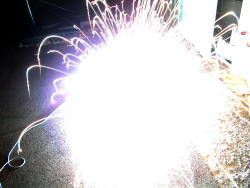 (click to enlarge)
(click to enlarge)
The left photo shows the capacitor bank connected to heavy copper bus
bars with 1 x 4 inch aluminium foil across them. .The right photo
shows the flash when fired.
Note that part of this flash is the 1500 joules and part is due to ignition
of the aluminium as there is very little of it left. Aluminium is explosive
when powdered and is used for
flash/bang
or stun grenades. Check this out for a really serious
capacitor bank
( 60 MJ ).

Railgun 1 2004.
A rail gun
is a method of converting electrical power into kinetic energy of a metal
projectile. The fastest projectiles known used magnetic propulsion to achieve speeds
of many km/s (record of 12 miles/s (20 km/s) by
Sandia Labs) and efficiencies up to 30%.
The principle is simple - pump 1,000,000 amps or so down 2 parallel
conductors joined by the movable conductive projectile. Lorenz magnetic forces down the
1 wire 'coil' push the projectile forward.
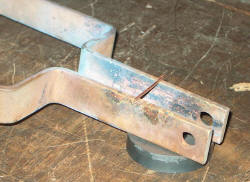 (click
to enlarge)
(click
to enlarge)
The power of the basic setup (above) is really is a bit low for a railgun due to
startup friction and I was rather surprised that it worked at all. Adding a
magnetic field helps using magnets from a magnetron out of a microwave oven. I have
a couple of more powerful 1 inch (2.5 cm) Neodymium Iron Boron N40 grade
magnets which will be interesting to try in this setup. This is run in
series with the unloaded coilgun coil to limit peak current. At best a thin
springy copper wire traveling along the center of the copper bars will
penetrate paper at 3 feet with a big flash and bang. Not really rocket
science yet.

Railgun 2 2004.
I have now completed a larger railgun.
This uses a pressurized air injector system with a
fast opening 230 V 7 W solenoid operated high pressure valve (16 bar) and is connected
to a 24 x 4 inch heavy PVC 'tank'. This has been tested to a pressure
of 8 bar = 120 psi (pounds per square inch) and seems to hold its pressure well. It
is constructed from schedule 12 (12 bar) pipe and schedule 18 (18 bar)
fittings so should be within tolerance. The weak spot where the
compressor valve enters is reinforced internally. I
have used P type PVC glue with methylethyl ketone primer for a higher pressure rating.
It gives a satisfying blast of air when activated.
The rails are constructed from brass bar and teflon strips of about 18
inches. The first 4 inches or so has polycarbonate insulator for
the rails to allow the air to give it some velocity before being
electrically accelerated.
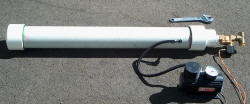

(click
to enlarge)
The left photo shows the air injector system with compressor and the
right photo shows the rail internals.
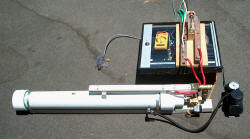
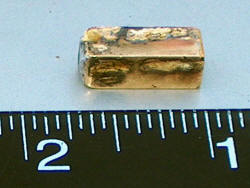 (click to enlarge)
(click to enlarge)
The left photo shows the completed railgun and the right photo
shows the projectile after a few firings (ruler in inches).
The railgun is powered by 4700 uF at 800 V and switch on is by the
projectile making contact with the rails. ( I am not using the SCR switching
for this). I have used a coil in series to limit the initial current
flow but it is clear from the flash seen through the teflon that this is
still only occurring in the first few inches or so. I would probably be
better off rearranging the caps to give 18,800 uF at 400 V
The projectile is brass square tube filled with solder (probably has as much
lead as a small bullet). It will drop through the railgun if vertical.
It is breech loaded through a T piece. After firing it is hot but still able
to be touched. At present it fires although how much is due to the air
pressure alone is unclear. I have been shooting into a soft target (so
I can recover my projectile).
To measure velocities, I need to set up the ballistic pendulum and work out
the maths to get results with and without the power applied. Unlike the
coilgun, care needs to be taken that the pendulum is not just being blown by
the flow of air from the muzzle which means it has to be a longer distance
away and be set up outside my shed. Velocity measurement is a problem
particularly as optical devices can get falsely triggered by the muzzle
flash.
Since I finished it I have now got graphite powder as a lubricant and also a
storage oscilloscope which should enable me to measure peak currents and
record them. I also have a couple of hockey puck SCR's rated at 1700 A as
potential replacements so I can push my present SCR harder and not worry if
I blow it.

Spud gun
2004
An amusing incidental use for this air injector is for a 'spud gun' or
'potato cannon'. Jam the end of a 15 mm copper pipe into a potato then
push the plug of potato down to the pressure end and 'fire'.
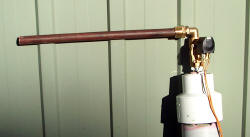 (click to enlarge)
(click to enlarge)
At 40 psi the
potato is shot out the end fast. It still seemed to be travelling
horizontally after 30 yards or so as it disappeared into the trees.
When aimed vertically, flight time was 5 seconds. I will
have to get out the ballistic pendulum to check the velocity.
Other people
have elevated spud guns to an art form. Recently, I needed a
length of copper pipe to make a high current coaxial resistor so I removed
about half the barrel length. This means that I now have a sawn-off
spudgun!

Coilgun 2004
This coilgun shown aiming into a ballistic pendulum with a can as the target. The
power is sufficient to go through the can. The centre barrel is a brass tube with longitudinal split
to prevent eddy currents.
Care is needed as this can shoot backwards with the wrong combination
of projectile size and starting position. I was getting 60 feet/s (20 m/s) calculated from 4.3 sec flight vertically. Compare this with a handgun at
600 feet/s (200 m/s) and it is not really a 'gun'. This is a simple single stage gun. In
contrast to the railgun it is almost silent in operation.
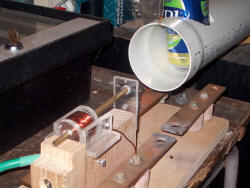 (click to enlarge)
(click to enlarge)
This is the world arsenal of proper hand
held coil guns.

Coilgun 3kJ
2006
I have used my big capacitor bank
to drive a coil gun at higher levels.
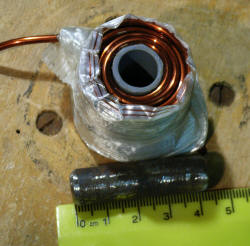 (click to enlarge)
(click to enlarge)
This shows a 46 turn coil about 4 cm diameter and about 5 cm long. The
iron rod projectile is just over 4 cm and weighs 33 g. I tried various
energies from 500 J to 3 kJ in sequence. Here is the last shot sequence. 2
kJ gave the most powerful shot and good deformation but not penetration of
the can.
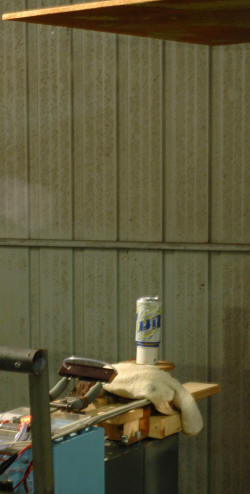
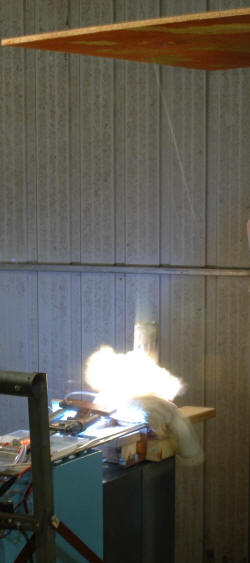 (click to enlarge)
(click to enlarge)
The left photo above shows the coil mounted vertically and covered by
some PVC. A can lies on top. The right photo shows the firing
at 3 kJ. It shows the can streaking upward, hitting the top
board and ricocheting backwards which is the faint streak extending down
from the upper board in the 1.3 second exposure. This was not due to the
projectile which didn't leave the barrel and was just due to the explosive
force from the coil disruption.
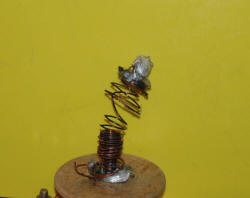 (click to enlarge)
(click to enlarge)
The result of 3 kJ on the coil. The forces on the coil are axial
compression and radial expansion leading to coil disruption and inter turn
shorting.

Handpowered
coilgun 2004
My original coilgun is a bit unique being portable and driven by a hand powered generator from an old
telephone handset in the original box . This charged a
5400 uF 225 V capacitor to a total of 136 joules. I also had a power
pack for times when the arms get sore as it takes a couple of minutes of
vigorous winding to charge. Not really fast on the draw. Switching was
with two metal contacts. It could just penetrate a cardboard box with an 8 g
iron rod.
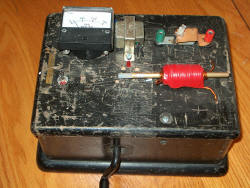
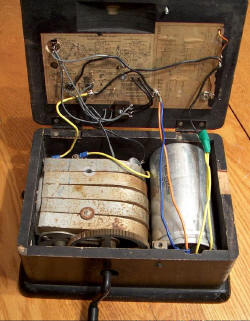 (click to enlarge)
(click to enlarge)

Future plans:

